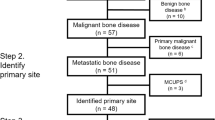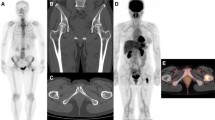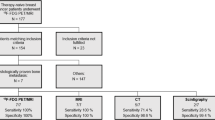Abstract
Objective
Bone metastasis occurs frequently in nasopharyngeal carcinoma (NPC) patients. The aim of this study was to compare the clinical value of 18F-FDG PET/CT with that of 99mTc-MDP planar bone scintigraphy (PBS) for detecting bone metastasis in NPC patients.
Methods
Thirty-five histologically proven NPC patients were enrolled in this retrospective study. They underwent both 18F-FDG PET/CT and PBS within 7 days in our department. In a lesion-based analysis, the skeletal system, excluding the head, was divided into four regions: the spine, the pelvis, the thorax, and the appendix. Bone metastasis was considered to be present by either biopsy or clinical follow-up for at least 6 months. PET/CT and PBS were compared by McNemar’s paired-sample test.
Results
A total of 50 lesions were confirmed to be malignant (spine 27, thorax 11, pelvis 8 and appendix 4). Although PET/CT was found to be more sensitive on lesion level than PBS (sensitivity 70.0 versus 42.0 %; P = 0.044), there were still 14 metastatic (28.0 %) lesions that could be detected by PBS while negative in PET/CT imaging. In a patient-based analysis, fifteen (42.9 %) of 35 eligible patients were found to have bone metastasis. The sensitivity, specificity and accuracy of PET/CT was 60.0 % (9/15), 100 % (20/20) and 82.9 % (29/35); as for PBS, it was 66.7 % (10/15), 85.0 % (17/20) and 77.1 % (27/35), respectively. There was no statistical difference between PET/CT and PBS (P > 0.05).
Conclusions
PBS, as a conventional imaging, should be used as an important complement for detecting bone metastasis in NPC patients.


Similar content being viewed by others
References
Jemal A, Bray F, Center MM, Ferlay J, Ward E, Forman D. Global cancer statistics. CA Cancer J Clin. 2011;61:69–90.
Chiesa F, De Paoli F. Distant metastases from nasopharyngeal cancer. ORL J Otorhinolaryngol Relat Spec. 2001;63:214–6.
Algra PR, Bloem JL, Tissing H, Falke TH, Arndt JW, Verboom LJ. Detection of vertebral metastases: comparison between MR imaging and bone scintigraphy. Radiographics. 1991;11:219–32.
Iagaru A, Young P, Mittra E, Dick DW, Herfkens R, Gambhir SS. Pilot prospective evaluation of 99mTc-MDP scintigraphy, 18F NaF PET/CT, 18F FDG PET/CT and whole-body MRI for detection of skeletal metastases. Clin Nucl Med. 2013;38:e290–6.
Czernin J, Weber WA, Herschman HR. Molecular imaging in the development of cancer therapeutics. Annu Rev Med. 2006;57:99–118.
Jager PL, de Korte MA, Lub-de Hooge MN, van Waarde A, Koopmans KP, Perik PJ, et al. Molecular imaging: what can be used today. Cancer Imaging. 2005;5:S27–32.
Liu T, Cheng T, Xu W, Yan WL, Liu J, Yang HL. A meta-analysis of 18FDG-PET, MRI and bone scintigraphy for diagnosis of bone metastases in patients with breast cancer. Skeletal Radiol. 2011;40:523–31.
Liu T, Xu JY, Xu W, Bai YR, Yan WL, Yang HL. Fluorine-18 deoxyglucose positron emission tomography, magnetic resonance imaging and bone scintigraphy for the diagnosis of bone metastases in patients with lung cancer: which one is the best?–a meta-analysis. Clin Oncol (R Coll Radiol). 2011;23:350–8.
Chang MC, Chen JH, Liang JA, Lin CC, Yang KT, Cheng KY, et al. Meta-analysis: comparison of F-18 fluorodeoxyglucose-positron emission tomography and bone scintigraphy in the detection of bone metastasis in patients with lung cancer. Acad Radiol. 2012;19:349–57.
Liu FY, Chang JT, Wang HM, Liao CT, Kang CJ, Ng SH, et al. [18F]fluorodeoxyglucose positron emission tomography is more sensitive than skeletal scintigraphy for detecting bone metastasis in endemic nasopharyngeal carcinoma at initial staging. J Clin Oncol. 2006;24:599–604.
Drieskens O, Oyen R, Van Poppel H, Vankan Y, Flamen P, Mortelmans L. FDG-PET for preoperative staging of bladder cancer. Eur J Nucl Med Mol Imaging. 2005;32:1412–7.
Apolo AB, Riches J, Schöder H, Akin O, Trout A, Milowsky MI, et al. Clinical value of fluorine-18 2-fluoro-2-deoxy-d-glucose positron emission tomography/computed tomography in bladder cancer. J Clin Oncol. 2010;28:3973–8.
Yang Z, Pan L, Cheng J, Hu S, Xu J, Ye D, et al. Clinical value of whole body fluorine-18 fluorodeoxyglucose positron emission tomography/computed tomography in the detection of metastatic bladder cancer. Int J Urol. 2012;19:639–44.
Weissleder R. Molecular imaging in cancer. Science. 2006;312:1168–71.
Hoffman JM, Gambhir SS. Molecular imaging the vision and opportunity for radiology in the future. Radiology. 2007;244:39–47.
Roodman GD. Mechanisms of bone metastasis. N Engl J Med. 2004;350:1655–64.
Liu NB, Zhu L, Li MH, Sun XR, Hu M, Huo ZW, et al. Diagnostic value of 18F-FDG PET/CT in comparison to bone scintigraphy, CT and 18F-FDG PET for the detection of bone metastasis. Asian Pac J Cancer Prev. 2013;14:3647–52.
Micheau C, Boussen H, Klijanienko J, Cvitkovic E, Stosic S, Schwaab G, et al. Bone marrow biopsies in patients with undifferentiated carcinoma of the nasopharyngeal type. Cancer. 1987;60:2459–64.
Sham JS, Cheung YK, Chan FL, Choy D. Nasopharyngeal carcinoma: pattern of skeletal metastases. Br J Radiol. 1990;63:202–5.
Chakraborty D, Bhattacharya A, Mete UK, Mittal BR. Comparison of 18F fluoride PET/CT and 99mTc-MDP bone scan in the detection of skeletal metastases in urinary bladder carcinoma. Clin Nucl Med. 2013;38:616–21.
Zhang Y, Shi H, Cheng D, Jiang L, Xiu Y, Li B, et al. Added value of SPECT/spiral CT versus SPECT in diagnosing solitary spinal lesions in patients with extraskeletal malignancies. Nucl Med Commun. 2013;34:451–8.
Conflict of interest
No conflict of interest.
Author information
Authors and Affiliations
Corresponding author
Rights and permissions
About this article
Cite this article
Yang, Z., Zhang, Y., Shi, W. et al. Is 18F-FDG PET/CT more reliable than 99mTc-MDP planar bone scintigraphy in detecting bone metastasis in nasopharyngeal carcinoma?. Ann Nucl Med 28, 411–416 (2014). https://doi.org/10.1007/s12149-014-0831-z
Received:
Accepted:
Published:
Issue Date:
DOI: https://doi.org/10.1007/s12149-014-0831-z




